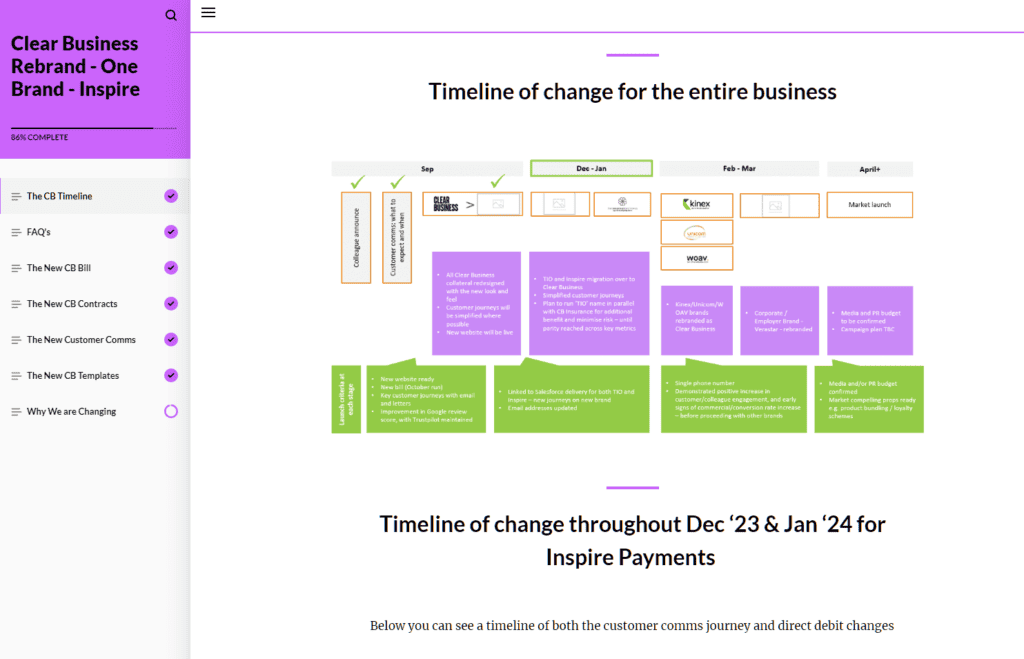Change management is a critical component of any major transformation within an organization, and rebranding is no exception.
A company’s brand is not just its logo or tagline; it represents its market identity—who they are, what they do, the quality of their products or services, their reputation for trustworthiness, and more.
When a company decides to undergo a rebranding exercise, it must manage this change meticulously to ensure that the transition is smooth and that the new brand is embraced by both customers and employees.
What is Rebranding?
Rebranding is a strategic process that a company or organization undergoes to change its corporate image, identity, or perception in the marketplace.
It involves making significant changes to elements such as the company name, logo, visual assets, messaging, and positioning to create a new brand identity.
Rebranding can be done to keep up with evolving consumer preferences, to differentiate from competitors, to target new markets, or to distance from a negative reputation.
It is a complex and multi-faceted undertaking that requires careful planning, market research, and creative execution to successfully reintroduce and reposition a brand in the minds of consumers.
The Benefits of Rebranding
Rebranding can bring a host of benefits to your business. By updating your brand’s appearance and message, you can increase visibility in the marketplace and stand out from competitors. Sometimes, rebranding can be done to change the negative image of a brand.
This can lead to enhanced credibility and trust among potential customers, ultimately expanding your customer base. In a rapidly changing market, rebranding is crucial for staying relevant and signaling to the target audience that your business is evolving to meet their needs.
When considering a rebranding strategy, it’s important to first identify the need for a partial or total rebrand.
This involves re-establishing the target market and redefining the company’s vision, mission, and values to better align with market changes.
This strategic approach ensures that the rebranding effectively communicates the company’s evolution and enhances its position in the marketplace.
By understanding the benefits of rebranding and implementing a thoughtful strategy, businesses can adapt to market changes and propel their success.

What is Change Management?
Change management is a vital process that organizations must embrace to navigate through transitions effectively. It involves planning, implementing, and managing changes in a structured way to minimize resistance and maximize the benefits of change.
Without change management, there are significant risks associated with rebranding, as the organization may struggle to gain buy-in from its workforce and key stakeholders.
The essential elements of change management include addressing the “why” behind the change, assessing its impact on various audiences, cultivating awareness, educating and training audiences, and propelling employees to embody the new direction. These deliberate activities are crucial in facilitating and supporting individual and organizational change.
Change management ensures that the transition and transformation are managed in a strategic and thoughtful manner.
It provides a framework for understanding the nature of the change, its impact, and the steps needed to guide individuals and the organization as a whole through the process, ultimately leading to a successful and sustainable transformation.
Key Steps in the Change Management Process:
- Identifying all stakeholders: This involves recognizing everyone who will be affected by the change, whether directly or indirectly, and understanding their perspectives and concerns.
- Understanding the impact of the change: It is crucial to assess how the transformation will affect different departments, processes, and individuals within the organization.
- Creating consistent and clear communication: Establishing open and transparent communication channels is essential for keeping all stakeholders informed about the change, addressing their questions and concerns, and maintaining their support throughout the process.
Addressing the purpose for the transformation is crucial for fostering understanding and buy-in from employees.
It helps clarify why the change is necessary, what its implications are for the organization, and how it will impact employees’ jobs.
Clearly articulating the purpose also allows employees to see the bigger picture and understand the value of their role in the change management process.
This, in turn, can help reduce resistance to the change and increase commitment to the new direction. By addressing the purpose, organizations can ensure that employees are aligned with the change and are empowered to contribute to its successful implementation.
The Case Study: Clear Business Ltd Rebranding
In the UK there are a number of business to business brands all belonging to Verastar Ltd. These brands typically offer the same set of services (telecommunication and utilities) to business customers, with each brand going to market in a different manner (e.g. kinex uses traditional sales techniques, other brands use third party sales teams or internet marketing).
Verastar has augmented its organic growth with strategic acquisitions that have added additional products and services that can be cross-sold into the customer base.
Verastar’s decision to consolidate different brands into one unified brand, Clear Business, stems from a desire for simplicity and clarity in its market presence.
The move towards one brand aims to eliminate confusion among customers and streamline internal processes.
This strategic shift requires careful planning and execution through effective change management practices.
Why Verastar/Clear Business are Rebranding
The rationale behind Clear Business’ rebranding initiative includes:
1. Simplifying Customer Experience: Multiple brands can lead to customer confusion. A single brand makes it easier for customers to understand the offerings and engage with the company.
2. Building Trust: Consistent branding across all touchpoints enhances recognition and trust with customers.
3. Operational Efficiency: Maintaining several brands can be resource-intensive. One cohesive brand reduces complexity in marketing materials, communication efforts, customer service interactions, etc.
4. Cross-Selling Opportunities: With one brand umbrella, there’s potential for more effective sales conversations as customers may be more inclined to purchase additional products from a familiar supplier.
Timeline for Clear Business Rebranding
The first step in their rebranding journey was moving their existing customers over to the new brand.
This involved updating various touchpoints such as websites, emails, bills, letters, and social media platforms with a new look and tone of voice.
However, it was important for Clear Business to ensure that these changes did not disrupt their customers’ services or supplies.
To effectively manage this transition, Clear Business developed a clear timeline detailing each phase of the rebranding process, from initial customer communications about the changes starting on November 29th until completion on December 6th, ensuring transparency throughout the transition period.

This timeline helped them stay organized and ensured that all necessary steps were taken at the right time.
It also provided transparency for employees regarding what changes would be happening when.
Communication Is Key
Effective communication lies at the heart of successful change management during rebranding exercises like that of Clear Business:
Internal Communication: Employees need to understand why rebranding is happening, the vision behind it, and how it will affect them before they can communicate effectively with external stakeholders.
Customer Communication: Customers should be informed about what changes are coming up but also reassured that these won’t disrupt their services or relationship with the company.
Consistent Messaging Across Channels: Whether through emails designed primarily for mobile viewing or social media updates—all messaging should align with the new branding strategy while maintaining clarity about ongoing operations.
Clear Business understood that keeping everyone informed about the changes was essential for successful implementation.
They used various communication channels such as emails, bill notifications, social media updates, and even designated Brand Ambassadors within their organization who could answer questions from colleagues or customers.
By proactively communicating with their stakeholders about the reasons behind the rebranding exercise and how it would benefit them in terms of improved customer experience and increased business value, Clear Business gained support from within their organization as well as from external partners.
Implementing Change Management During Rebranding
One of the key benefits of effective change management during a rebranding exercise is that it helps minimize resistance to change. People are naturally resistant to change, especially when it involves something as significant as a company’s brand identity.
Here’s how organizations can apply change management principles during such transitions:
- Leadership Alignment & Vision Casting: Leadership must fully endorse the new direction so they can convincingly communicate this vision throughout every level of the organization.
- Stakeholder Engagement: Engage key stakeholders early in planning stages—this includes employees who will become ambassadors of your new brand as well as partners or suppliers who might also be affected by these changes.
- Training & Support: Provide training sessions so employees understand how to convey messages regarding new branding consistently across various platforms. Offer support structures like Brand Ambassadors who are equipped with answers—or know where to find them—to assist colleagues during transitional periods.
- Feedback Loops: Establish mechanisms for feedback from both staff members and customers which helps identify areas needing further clarification or adjustment during implementation phases.
- Celebrating Milestones: Recognize milestones along your journey; celebrate successes related directly back to your team’s efforts in bringing about this significant change within your organization—it boosts morale!
- Monitoring & Evaluation: Continuously monitor progress against set goals (like increased engagement metrics) post-re-launch; evaluate strategies periodically ensuring alignment with overall business objectives moving forward after initial rollout has been completed successfully.
Goals and Objectives of Rebranding Initiative
Let’s have a closer look at goals you might consider during a rebranding. They might include:
- Increasing brand awareness by 30% within the first year
- Growing customer engagement on social media platforms by 50%
- Boosting sales by 15%
Tracking metrics for success will include website traffic, social media engagement, customer surveys, and sales data.
Coca-Cola’s successful rebranding journey involved refreshing their logo and packaging to reflect a modern and dynamic image, while Apple’s rebranding focused on innovation and simplicity, leading to increased market share and customer loyalty.
Nike’s rebranding strategy emphasized their commitment to empowering athletes, resulting in a stronger connection with their target audience and increased sales.
The rebranding strategy will involve creating a comprehensive brand identity, including a new logo, visual elements, and messaging that align with the company’s values and resonates with the target audience.
The launch will include a multi-channel marketing campaign, including social media, digital advertising, and public relations efforts to generate excitement and build awareness around the new brand identity.

Identifying Target Audience & Potential Customers
Our target audience and potential customers can be segmented into different groups based on demographics, psychographics, and purchasing behaviors.
Demographics include factors such as age, gender, income level, and education. Psychographics involve interests, values, lifestyles, and attitudes.
Purchasing behaviors encompass the frequency of purchases, brand loyalty, and decision-making processes.
To resonate with a target audience, rebranding efforts should focus on crafting a brand identity that speaks directly to their desires.
For example: A target audience of primarily young professionals aged 25-35, with a higher education level and a moderate to high income who are environmentally conscious and seek products that align with their values. They prioritize convenience and are willing to pay more for sustainable and ethical products.
The rebrand should include highlighting the sustainable and ethical aspects of our products, showcasing convenience and ease of use, and leveraging social media and influencer partnerships to reach this tech-savvy demographic.
By understanding the demographics, psychographics, and purchasing behaviors of our target audience, we can tailor our rebranding to effectively connect with and engage our potential customers.
Creating a Visual Identity & Color Scheme
Creating a visual identity and color scheme during a rebrand is crucial for several reasons:
1. Brand Recognition: A distinctive visual identity helps customers instantly recognize the brand across various platforms and marketing materials. This recognition is vital in building a strong presence in the market, as it allows consumers to identify the company’s products or services quickly.
2. Emotional Connection: Colors and visuals can evoke emotions and convey messages without words. By carefully selecting colors that align with the brand’s values and message, companies can create an emotional connection with their audience, which can influence perception and encourage loyalty.
3. Consistency Across Touchpoints: A consistent visual identity ensures that no matter where customers interact with the brand—be it online, in print, or in person—they have a cohesive experience. This consistency reinforces the brand’s professionalism and reliability.
4. Differentiation from Competitors: In crowded markets, having a unique color scheme and design elements can set a brand apart from its competitors. It helps to establish a unique position in consumers’ minds, making it easier for them to choose one brand over another.
5. Internal Unity & Pride: For employees, a well-designed visual identity serves as a source of pride and unity; it gives them something tangible to rally behind and represents the collective effort of the organization.
6. Communication of Brand Evolution: As businesses evolve, so too should their branding reflect this growth and change. A new visual identity can signal to stakeholders that the company is adapting to new trends or shifting its focus while still maintaining its core essence.
7. Supports Marketing Strategy: An effective color scheme enhances marketing efforts by ensuring all communications are aligned with what the brand stands for; this makes marketing campaigns more efficient as they resonate more deeply with target audiences due to consistent use of visuals that support campaign themes.
Once decisions have been made regarding this visual identity, you should create brand guidelines.
Creating Branding Guidelines
Brand guidelines, also known as brand standards or style guides, are a set of rules that explain how a brand’s identity should be communicated across various media and channels.
They serve as a reference for the correct use of brand elements to ensure consistency and coherence in the representation of the brand.

These guidelines typically include:
Logo Usage: Instructions on how to use the logo, including sizing, spacing, what not to do with the logo, and variations for different backgrounds.
Color Palette: Specification of primary and secondary colors with exact color codes (e.g., CMYK, RGB, HEX) for consistent reproduction across print and digital mediums.
Typography: Details about typefaces that are part of the brand’s visual identity, including fonts for headings, body text, and any special styling notes.
Imagery Style: Guidance on the types of images that reflect the brand’s ethos; this may include photography style, illustrations, iconography guidelines etc.
Voice & Tone: Description of the brand’s personality in written communication which influences how copy is written for advertising materials, social media posts etc.
Layouts & Grids: Templates or grids for standard documents like business cards, letterheads or marketing collateral to maintain visual harmony across all materials.
Application Examples: Mock-ups showing how branding elements should be applied in different contexts such as merchandise packaging or digital ads.
Legal Guidelines: Information on trademark usage and restrictions regarding where and how certain aspects of the brand can be used legally by internal teams or external partners/vendors.
By adhering to these guidelines everyone who works on communicating the brand—from employees to external agencies—can ensure they’re representing it correctly which helps build recognition trust among customers over time while also protecting its legal trademarks copyrights from misuse dilution.
How did Verastar approach change management in their rebranding to Clear Business?
Verastar approached rebranding to Clear Business by dealing with change management techniques strategically. They focused on transparent communication, employee engagement, and addressing resistance to ensure a smooth transition. By embracing change management principles, they successfully navigated the rebranding process, maintaining employee morale and customer satisfaction.
Final Thoughts
Managing change effectively when undertaking something as significant as a corporate rebrand involves much more than updating logos—it’s about reshaping perceptions internally first then externally while maintaining operational continuity throughout this transformative process.
By applying structured change management methodologies, as demonstrated by Clear Business, a company ensures not only smoother transitions but also sets itself up for long-term success under its refreshed identity.
Remember: Change isn’t just managed; it’s led strategically—with purposeful communication being integral at every step along this exciting yet challenging path toward reinvention!
Sources
https://www.websiteplanet.com/blog/logo-rebranding-evolution-nike-logo/
https://missdetails.com/a-great-example-of-re-branding-apple-inc/
https://www.linkedin.com/pulse/nike-brand-empowering-athletes-redefining-branding-tsarielashvili





